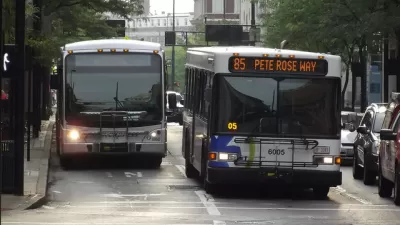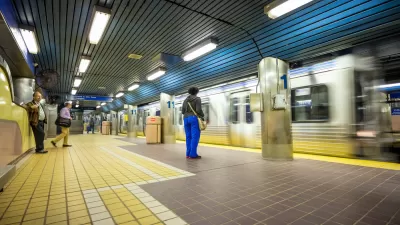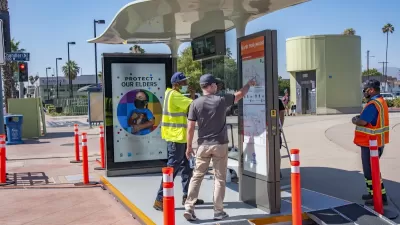All over the country, sorry bus stops lack seating. Studies show that deficiency can depress ridership, some motivated citizens are looking to change that.

Any frequent bus rider knows all stops aren’t created equal. Sorry bus stops can leave riders waiting without shelter or the all-important place to sit. While benches are an inexpensive amenity for cities to provide, many don’t, that can be where enterprising citizens come in.
Non-for-profit Tiny WPA in Philadelphia designed an accessibility friendly bench. "They don’t look like your typical benches: Part of the seat is raised higher than normal and angled upwards, with a vertical pole attached, to assist older adults in sitting down and standing up," Linda Poon writes for CityLab. In Los Angeles, one concerned citizen has been installing difficult-to-remove benches that wrap abound poles. These benches went in without city approval, and the artist was anonymously interviewed in the Los Angeles Times.
The Better Bus Coalition of Cincinnati has also installed guerrilla benches, chaining them to sign posts with the message “This bench supports bus riders more than the city does.” Lack of seating at bus stops has long been an issue in the city "where the city council, citing improper maintenance, began removing ad-sponsored benches back in 2006," Poon writes.
Comfortable bus stops are important, because they improve the quality of the experience for riders, but they also have other benefits. "Better amenities can boost ridership, according to a Transit Center report and, given the worrying state of bus use nationwide, installing better benches should be a low-cost way for cities to address a low-hanging fruit," Poon argues.
FULL STORY: Take a Seat: 5 Brilliant Bus Stop Fixes

Trump Administration Could Effectively End Housing Voucher Program
Federal officials are eyeing major cuts to the Section 8 program that helps millions of low-income households pay rent.

Planetizen Federal Action Tracker
A weekly monitor of how Trump’s orders and actions are impacting planners and planning in America.

Ken Jennings Launches Transit Web Series
The Jeopardy champ wants you to ride public transit.

Washington Legislature Passes Rent Increase Cap
A bill that caps rent increases at 7 percent plus inflation is headed to the governor’s desk.

From Planning to Action: How LA County Is Rethinking Climate Resilience
Chief Sustainability Officer Rita Kampalath outlines the County’s shift from planning to implementation in its climate resilience efforts, emphasizing cross-departmental coordination, updated recovery strategies, and the need for flexible funding.

New Mexico Aging Department Commits to Helping Seniors Age ‘In Place’ and ‘Autonomously’ in New Draft Plan
As New Mexico’s population of seniors continues to grow, the state’s aging department is proposing expanded initiatives to help seniors maintain their autonomy while also supporting family caregivers.
Urban Design for Planners 1: Software Tools
This six-course series explores essential urban design concepts using open source software and equips planners with the tools they need to participate fully in the urban design process.
Planning for Universal Design
Learn the tools for implementing Universal Design in planning regulations.
Heyer Gruel & Associates PA
Ada County Highway District
Institute for Housing and Urban Development Studies (IHS)
City of Grandview
Harvard GSD Executive Education
Toledo-Lucas County Plan Commissions
Salt Lake City
NYU Wagner Graduate School of Public Service





























